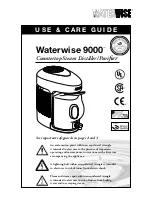
RT-SVX074A-EN
45
Unit Start-Up
Sequence of Operation
See ACC-APG002*-EN, Application Guide, Symbio™ 700
Controller with Precedent™ Packaged Rooftop Air-
Conditioners.
Return Air Smoke Detector
The return air smoke detector is designed to shut off the
unit if smoke is sensed in the return air stream. Sampling
the airflow entering the unit at the return air opening
performs this function.
In order for the smoke detector to properly sense smoke in
the return air stream, the air velocity entering the unit must
be between 500 and 4000 feet per minute. Equipment
covered in this manual will develop an airflow velocity that
falls within these limits over the entire airflow range
specified in the evaporator fan performance tables.
Compressor Start-Up
WARNING
Live Electrical Components!
Failure to follow all electrical safety precautions when
exposed to live electrical components could result in
death or serious injury.
When it is necessary to work with live electrical
components, have a qualified licensed electrician or
other individual who has been properly trained in
handling live electrical components perform these
tasks.
1. Attach a set of service gauges onto the suction and
discharge gauge ports for each circuit.
Proceed to the next Service Test step if continuing from
previous component start-up or until the desired start-
up component test is started.
2. After the compressor and condenser fan have started
and operated for approximately 30 minutes, observe
the operating pressures. Compare the operating
pressures to the label on the access panel.
3. Check system superheat. Follow the instruction listed
on the superheat charging curve in the Service Facts.
Superheat should be within ±5ºF of the superheat chart
value.
4. Repeat steps 1 through 4 for each refrigerant circuit.
5. To stop the SERVICE TEST, turn the main power
disconnect switch to the “Off” position or proceed to the
next component start-up procedure. Remove
electromechanical test mode connections (if
applicable).
Hot Gas Reheat
WARNING
Live Electrical Components!
Failure to follow all electrical safety precautions when
exposed to live electrical components could result in
death or serious injury.
When it is necessary to work with live electrical
components, have a qualified licensed electrician or
other individual who has been properly trained in
handling live electrical components perform these
tasks.
Set the unit to Service Test step Reheat. Once the unit is in
the reheat test mode, verify that the 3 way valve has shifted
to the reheat position and that the supply temperature rises
10ºF more than when in cooling mode stage 2.
Monitor the suction pressure for 15 minutes. The suction
pressure should remain within 5 psi of normal cooling
operation. If the unit has a 2 speed outdoor fan and if the
outdoor air temperature is below 70°F, verify that the OD
fan is in low speed.
1. Clamp an amp meter around one of 1st stage heater
power wires at the heater contactor.
2. Using the Service Test Guide in
continue the SERVICE TEST start-up procedure for
each compressor circuit.
Select the next desired Service Test Mode if continuing
from previous component start up or exit Service Test if
complete.
Final System Setup
After completing all of the pre-start and startup procedures
outlined in the previous sections (i.e., operating the unit in
each of its modes through all available stages of cooling
and heating), perform these final checks before leaving the
unit:
•
Program the Night Setback (NSB) panel (if applicable)
for proper unoccupied operation. Refer to the
programming instructions for the specific panel.
•
Verify that the Remote panel “System” selection switch,
“Fan” selection switch, and “Zone Temperature”
settings for automatic operation are correct.
•
Inspect the unit for misplaced tools, hardware, and
debris.
•
Verify that all exterior panels including the control panel
doors and condenser grilles are secured in place.
•
Close the main disconnect switch or circuit protector
switch that provides the supply power to the unit’s
terminal block or the unit mounted disconnect switch.
















































